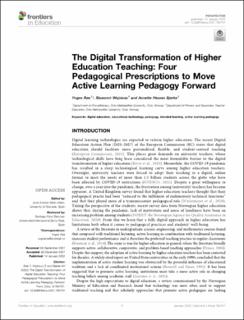| dc.contributor.author | Røe, Yngve | |
| dc.contributor.author | Wojniusz, Slawomir | |
| dc.contributor.author | Bjerke, Annette Hessen | |
| dc.date.accessioned | 2022-02-23T10:15:48Z | |
| dc.date.available | 2022-02-23T10:15:48Z | |
| dc.date.created | 2022-01-14T08:16:16Z | |
| dc.date.issued | 2022-01-14 | |
| dc.identifier.issn | 2504-284X | |
| dc.identifier.uri | https://hdl.handle.net/11250/2980954 | |
| dc.description.abstract | Digital learning technologies are expected to reform higher education: The recent Digital Education Action Plan (2021–2027) of the European Commission (EC) states that digital education should facilitate more personalised, flexible, and student-centred teaching (European Commission, 2021). This places great demands on university teachers, whose technological skills have long been considered the most formidable barrier to the digital transformation of higher education (Børte et al., 2020). Meanwhile, the COVID-19 pandemic has resulted in a steep technological learning curve among higher education teachers. Overnight, university teachers were forced to adapt their teaching to a digital, online format to meet the needs of more than 1.5 billion students across the globe who have been affected by COVID-19 restrictions (UNESCO, 2021). Despite a great willingness to change, over a year into the pandemic, the frustration among (university) teachers has become apparent. A United Kingdom survey found that higher education teachers thought that their pedagogical practis had been “reduced to the fulfilment of rudimentary technical functions” and that they played more of a transmissionist pedagogical role (Watermeyer et al., 2020). Taking the perspective of the students, recent survey data from Norwegian higher education shows that, during the pandemic, lack of motivation and sense of loneliness have been an increasing problem among students (NOKUT the Norwegian Agency for Quality Assurance in Education, 2020). From this we learn that a fully digital approach in higher education has limitations both when it comes to pedagogical practices and students’ well-being. | en_US |
| dc.language.iso | eng | en_US |
| dc.publisher | Frontiers Media | en_US |
| dc.relation.ispartofseries | Frontiers in Education;January 2022 | Volume 6 | Article 784701 | |
| dc.relation.uri | https://www.frontiersin.org/articles/10.3389/feduc.2021.784701/full?&utm_source=Email_to_authors_&utm_medium=Email&utm_content=T1_11.5e1_author&utm_campaign=Email_publication&field=&journalName=Fronti | |
| dc.rights | Navngivelse 4.0 Internasjonal | * |
| dc.rights.uri | http://creativecommons.org/licenses/by/4.0/deed.no | * |
| dc.subject | Digital education | en_US |
| dc.subject | Educational technology | en_US |
| dc.subject | Pedagogy | en_US |
| dc.subject | Blended learning | en_US |
| dc.subject | Active learning pedagogy | en_US |
| dc.title | The Digital Transformation of Higher Education Teaching: Four Pedagogical Prescriptions to Move Active Learning Pedagogy Forward | en_US |
| dc.type | Peer reviewed | en_US |
| dc.type | Journal article | en_US |
| dc.description.version | publishedVersion | en_US |
| dc.rights.holder | © 2022 Røe, Wojniusz and Bjerke | en_US |
| dc.source.articlenumber | 784701 | en_US |
| cristin.ispublished | true | |
| cristin.fulltext | original | |
| cristin.qualitycode | 1 | |
| dc.identifier.doi | https://doi.org/10.3389/feduc.2021.784701 | |
| dc.identifier.cristin | 1980881 | |
| dc.source.journal | Frontiers in Education | en_US |
| dc.source.volume | 6 | en_US |
| dc.source.pagenumber | 1-6 | en_US |

